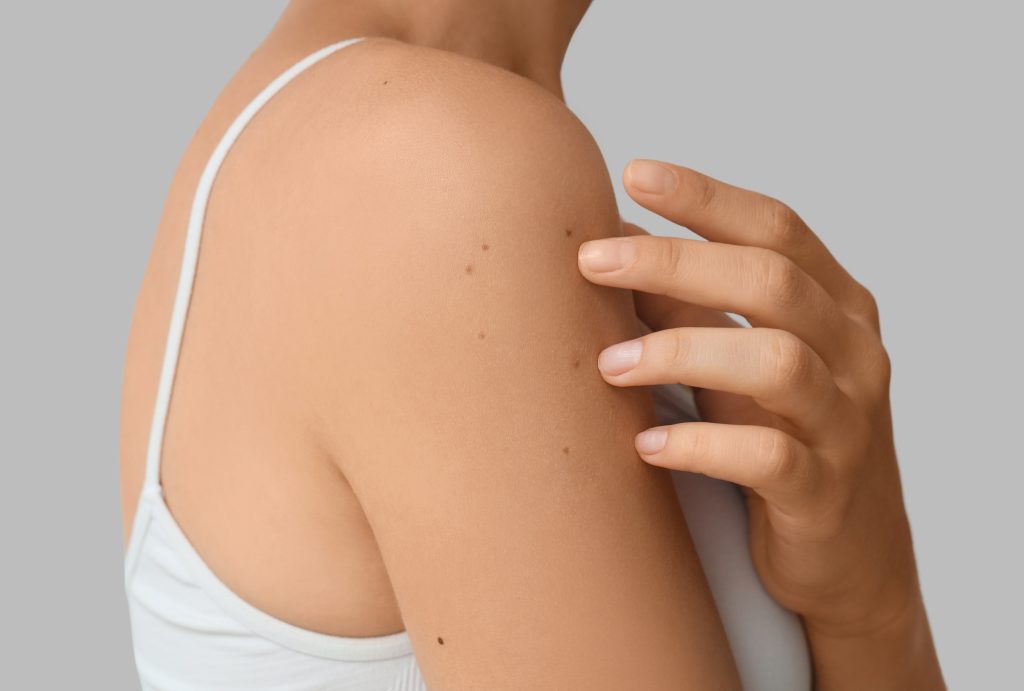
When detected early and treated properly, most skin cancers are curable. That means, the sooner you find a skin cancer and have it treated, the better outcome you are likely to have. At Florida Dermatology and Skin Cancer Centers, we recommend everyone have an annual skin exam with a licensed dermatology professional to help catch any issues and treat them before they become complications. In addition, we also recommend everyone conduct regular skin self-exams between their yearly skin checks, as it is also a great way to catch skin cancer early. If you’ve never checked yourself, now is the perfect time to start!
Keep reading for more information on what a skin self-exam is, why it’s so important, tips on how to perform a skin self-exam, and when you should see a professional.
What is a Skin Self-Exam?
A skin self-exam is a regular check of your skin that you conduct, from scalp to soles, to identify any new, changing, or unusual spots. You can give yourself a skin exam once a month, and it typically takes about 10 minutes or less.
While your dermatologist conducts professional skin exams, self-checks help you monitor your skin between visits, increasing the chances of catching anything concerning early on.
Why Are Skin Self-Exams Important?
Skin self-exams are important for the early detection of skin conditions, including skin cancer. Skin cancer is the most common cancer in the U.S. and research suggests that 1 in 5 Americans will develop skin cancer during their lifetime. Approximately 9,500 people are diagnosed with skin cancer every day. *
Anyone can develop skin cancer, regardless of skin color. The most common cause of cancerous changes is exposure to harmful ultraviolet radiation from the sun and artificial tanning beds. The sun’s ultraviolet rays damage the DNA in your skin cells and lead to cell mutation and formation of malignant tumors.
The positive news is that with early identification and diagnosis, skin cancer is highly treatable. If cancerous changes are detected in the early stages, treatment has a much higher likelihood of being effective. This is the primary reason why performing regular skin checks on yourself and getting an annual skin exam are important and proactive steps you can take to protect your skin and prevent cancerous growths from worsening.
Regular examinations are even more crucial if you are at high risk due to a compromised immune system, a personal history of skin cancer or a family history of skin cancer.
Tips for Performing a Self-Exam
You know the normal patterns of your moles, freckles, birthmarks, and other skin blemishes best, which makes you the best person to detect new or unusual changes when they occur. When performing a skin self-exam, take note of new moles, spots, sores, growths, or lesions. Keep track of spots that change in size or color, as well as spots that bleed, itch, ooze and don’t heal after a few weeks. If you notice anything new or unusual during an exam, contact your dermatologist and make an appointment to have it checked out by a professional.
Here are some tips you can follow when examining yourself:
- Perform the self-exam in a well-lit room in front of a full-length mirror. Have a hand mirror nearby to help you reach hard-to-see places.
- Check everywhere, even areas of your skin that don’t receive much sun exposure. Start by using the full-length mirror to examine your skin from the front, back and along each side of your body with your arms raised. Check your face, lips, and the front of your ears. Check the forearm and underarm of each arm, as well as the shins and calves of each leg. If you’re a woman, lift each breast to examine the undersides.
- Use a hand mirror to view hard-to-see places like the back of the neck, behind the ears, the backs of the thighs, the knee creases, the buttocks, and the genital region. You can also use a hand mirror combined with a blow dryer or comb to examine your scalp.
- Don’t forget the small places. Check under fingernails and toenails, between fingers and toes, the palms of the hands and the soles of the feet.
- For extremely hard-to-see places that you can’t see well, ask a partner or friend for help to look over.
Become familiar with what’s normal and what’s not for your skin – by doing so, you can be the biggest advocate for your own health if you notice a new or unusual change.
What to Look for During a Skin Exam
The best way to recognize an issue is by getting familiar with your skin’s normal appearance. Here’s what to watch for:
- New Moles or Growths – Look for any new spots that have developed or stand out and practice the ABCDEs of Melanoma:
- A – Asymmetry (one half doesn’t match the other)
- B – Border (irregular, blurred, or jagged edges)
- C – Color (uneven shades of brown, black, red, or white)
- D – Diameter (larger than a pencil eraser)
- E – Evolving (any noticeable change in size, shape, or behavior)
- Changes in Existing Moles – Watch for changes in size, shape, or color to the moles you already have.
- Sores That Don’t Heal – Make note of any spot that’s crusty, bleeding, or won’t heal after a few weeks.
Tips for Examining Yourself
- Take Pictures – If you’re unsure about a spot, take a picture to track changes over time.
- Ask for Help – A partner, friend, or family member can help check hard-to-see areas like your back.
- Be Consistent – Performing monthly checks makes it easier to spot real-time changes.
When to Schedule an Appointment with Your Dermatologist
If you notice any of the warning signs above, it’s time to call your dermatologist. Other reasons to schedule a visit include:
- A mole or spot that has changed rapidly
- A sore that won’t heal
- Itchy, painful, or bleeding skin lesions
- A family history of skin cancer
- A personal history of excessive sun exposure or tanning bed use
Make an Appointment with Florida Dermatology and Skin Cancer Centers
Along with completing your own skin self-exams at home, you should make an appointment with your dermatologist for a skin check once a year. No two individuals have the exact same skin, and what works for one may not work for another. Annual skin exams allow dermatologists to assess your unique skin type, identifying specific needs and challenges. Regular exams also help establish a baseline for your skin’s health, making it easier to identify anything that may require attention.
Ready to schedule? FLDSCC currently has several convenient locations across the state of Florida – find the office location closest to you and call us to book your appointment!
*The Skin Cancer Foundation Statistics 2025


